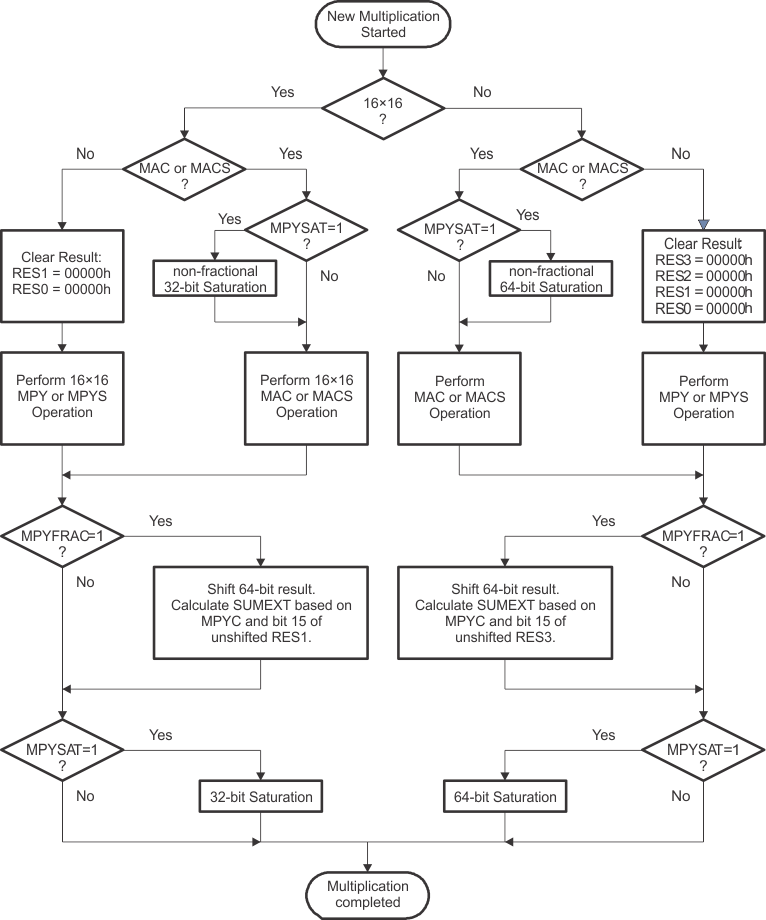SLAU367P October 2012 – April 2020 MSP430FR5041 , MSP430FR5043 , MSP430FR50431 , MSP430FR5847 , MSP430FR58471 , MSP430FR5848 , MSP430FR5849 , MSP430FR5857 , MSP430FR5858 , MSP430FR5859 , MSP430FR5867 , MSP430FR58671 , MSP430FR5868 , MSP430FR5869 , MSP430FR5870 , MSP430FR5872 , MSP430FR58721 , MSP430FR5887 , MSP430FR5888 , MSP430FR5889 , MSP430FR58891 , MSP430FR5922 , MSP430FR59221 , MSP430FR5947 , MSP430FR59471 , MSP430FR5948 , MSP430FR5949 , MSP430FR5957 , MSP430FR5958 , MSP430FR5959 , MSP430FR5962 , MSP430FR5964 , MSP430FR5967 , MSP430FR5968 , MSP430FR5969 , MSP430FR5969-SP , MSP430FR59691 , MSP430FR5970 , MSP430FR5972 , MSP430FR59721 , MSP430FR5986 , MSP430FR5987 , MSP430FR5988 , MSP430FR5989 , MSP430FR5989-EP , MSP430FR59891 , MSP430FR5992 , MSP430FR5994 , MSP430FR59941 , MSP430FR6005 , MSP430FR6007 , MSP430FR6035 , MSP430FR6037 , MSP430FR60371 , MSP430FR6041 , MSP430FR6043 , MSP430FR60431 , MSP430FR6045 , MSP430FR6047 , MSP430FR60471 , MSP430FR6820 , MSP430FR6822 , MSP430FR68221 , MSP430FR6870 , MSP430FR6872 , MSP430FR68721 , MSP430FR6877 , MSP430FR6879 , MSP430FR68791 , MSP430FR6887 , MSP430FR6888 , MSP430FR6889 , MSP430FR68891 , MSP430FR6920 , MSP430FR6922 , MSP430FR69221 , MSP430FR6927 , MSP430FR69271 , MSP430FR6928 , MSP430FR6970 , MSP430FR6972 , MSP430FR69721 , MSP430FR6977 , MSP430FR6979 , MSP430FR69791 , MSP430FR6987 , MSP430FR6988 , MSP430FR6989 , MSP430FR69891
5.2.5 Putting It All Together
Figure 5-5 shows the complete multiplication flow, depending on the various selectable modes for the MPY32 module.
 Figure 5-5 Multiplication Flow Chart
Figure 5-5 Multiplication Flow Chart Given the separation in processing of 16-bit operations (32-bit results) and 32-bit operations (64-bit results) by the module, it is important to understand the implications when using MAC/MACS operations and mixing 16-bit operands or results with 32-bit operands or results. User software must address these points during use when mixing these operations. The following code illustrates the issue.
; Mixing 32x24 multiplication with 16x16 MACS operation
MOV #MPYSAT,&MPY32CTL0 ; Saturation mode
MOV #052C5h,&MPY32L ; Load low word of 1st operand
MOV #06153h,&MPY32H ; Load high word of 1st operand
MOV #001ABh,&OP2L ; Load low word of 2nd operand
MOV.B #023h,&OP2H_B ; Load high word of 2nd operand
;... 5 NOPs required
MOV &RES0,R6 ; R6 = 00E97h
MOV &RES1,R7 ; R7 = 0A6EAh
MOV &RES2,R8 ; R8 = 04F06h
MOV &RES3,R9 ; R9 = 0000Dh
; Note that MPYC = 0!
MOV #0CCC3h,&MACS ; Signed MAC operation
MOV #0FFB6h,&OP2 ; 16x16 bit operation
MOV &RESLO,R6 ; R6 = 0FFFFh
MOV &RESHI,R7 ; R7 = 07FFFh
The second operation gives a saturated result because the 32-bit value used for the 16×16-bit MACS operation was already saturated when the operation was started; the carry bit MPYC was 0 from the previous operation, but the MSB in result register RES1 is set. As one can see in the flow chart, the content of the result registers are saturated for multiply-and-accumulate operations after starting a new operation based on the previous results, but depending on the size of the result (32 bit or 64 bit) of the newly initiated operation.
The saturation before the multiplication can cause issues if the MPYC bit is not properly set as the following code shows.
;Pre-load result registers to demonstrate overflow
MOV #0,&RES3 ;
MOV #0,&RES2 ;
MOV #0,&RES1 ;
MOV #0,&RES0 ;
; Saturation mode and set MPYC:
MOV #MPYSAT+MPYC,&MPY32CTL0
MOV.B #082h,&MACS_B ; 8-bit signed MAC operation
MOV.B #04Fh,&OP2_B ; Start 16x16 bit operation
MOV &RES0,R6 ; R6 = 00000h
MOV &RES1,R7 ; R7 = 08000h
Even though the result registers were loaded with all zeros, the final result is saturated. This is because the MPYC bit was set, causing the result used for the multiply-and-accumulate to be saturated to 08000 0000h. Adding a negative number to it would again cause an underflow, thus, the final result is also saturated to 08000 0000h.